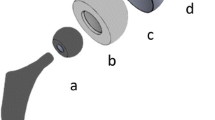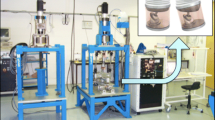Abstract
Purpose
Dual mobility THA implantations are increasing. THA survival of more than 15 years is considered long-term survival based on the Charnley prosthesis, which has a median wear rate of 39 to 98 mm3/year. What is the median wear rate of dual mobility THA cups and its repartition on the liner volume? What are the factors influencing dual mobility wear?
Methods
Thirty-five explants were analysed. The liners were entirely mapped with a fully automatic stripe light scanner that uses green LED light.
Results
The liners had a median wear rate of 38 mm3/year. The distribution of the wear between the two bearings varied greatly. No factor was found influencing wear volumes.
Conclusions
The median annual wear of dual mobility liners is at least as low as the wear of cemented polyethylene liners and lower than equivalent cementless liners. The two articulations of the dual mobility THA do not cause more wear.
Level of evidence
Level IV - case series.






Similar content being viewed by others
References
Charnley J (1972) The long-term results of low-friction arthroplasty of the hip performed as a primary intervention. J Bone Joint Surg (Br) 54:61–76
Caton J, Prudhon JL (2011) Over 25 years survival after Charnley’s total hip arthroplasty. Int Orthop 35:185–188. doi:10.1007/s00264-010-1197-z
Andrew TA, Berridge D, Thomas A, Duke RN (1985) Long-term review of ring total hip arthroplasty. Clin Orthop 111–122
Berry DJ, Harmsen WS, Cabanela ME, Morrey BF (2002) Twenty-five-year survivorship of two thousand consecutive primary Charnley total hip replacements: factors affecting survivorship of acetabular and femoral components. J Bone Joint Surg Am 84–A:171–177
Berend ME, Smith A, Meding JB et al (2006) Long-term outcome and risk factors of proximal femoral fracture in uncemented and cemented total hip arthroplasty in 2551 hips. J Arthroplast 21:53–59. doi:10.1016/j.arth.2006.05.014
Eingartner C, Heigele T, Volkmann R, Weise K (2006) Long-term results of an uncemented straight femoral shaft prosthesis. Hip Int 16:23–32
Engh CA, Claus AM, Hopper RH, Engh CA (2001) Long-term results using the anatomic medullary locking hip prosthesis. Clin Orthop 137–146
Epinette J-A, Manley MT (2008) Uncemented stems in hip replacement—hydroxyapatite or plain porous: does it matter? Based on a prospective study of HA Omnifit stems at 15-years minimum follow-up. Hip Int 18:69–74
Goosen JHM, Castelein RM, Runne WC et al (2006) Long-term results of a soft interface- (Proplast-) coated femoral stem. Acta Orthop 77:585–590. doi:10.1080/17453670610012647
Wroblewski BM (1986) 15–21-year results of the Charnley low-friction arthroplasty. Clin Orthop 30–35
Dumbleton JH, Manley MT, Edidin AA (2002) A literature review of the association between wear rate and osteolysis in total hip arthroplasty. J Arthroplast 17:649–661
Boyer B, Philippot R, Geringer J, Farizon F (2012) Primary total hip arthroplasty with dual mobility socket to prevent dislocation: a 22-year follow-up of 240 hips. Int Orthop 36:511–518. doi:10.1007/s00264-011-1289-4
Plummer DR, Haughom BD, Della Valle CJ (2014) Dual mobility in total hip arthroplasty. Orthop Clin N Am 45:1–8. doi:10.1016/j.ocl.2013.08.004
Boyer B, Neri T, Iorio AD et al (2017) The linear penetration rate is not relevant for evaluating wear of dual mobility cups: an explant study. Int Orthop 41(3):599–603. doi:10.1007/s00264-017-3406-5
Gaudin G, Ferreira A, Gaillard R, et al (2016) Equivalent wear performance of dual mobility bearing compared with standard bearing in total hip arthroplasty: in vitro study. Int Orthop 41(3):521–527. doi: 10.1007/s00264-016-3346-5
Philippot R, Boyer B, Farizon F (2012) Intraprosthetic dislocation: a specific complication of the dual-mobility system. Clin Orthop Relat Res 471(3):965–970. doi:10.1007/s11999-012-2639-2
Lecuire F, Benareau I, Rubini J, Basso M (2004) Intra-prosthetic dislocation of the Bousquet dual mobility socket. Rev Chir Orthop Reparatrice Appar Mot 90:249–255
Philippot R, Farizon F, Camilleri J-P et al (2008) Survival of cementless dual mobility socket with a mean 17 years follow-up. Rev Chir Orthop Reparatrice Appar Mot 94:e23–e27. doi:10.1016/j.rco.2007.10.013
Philippot R, Meucci JF, Boyer B, Farizon F (2013) Modern dual-mobility cup implanted with an uncemented stem: about 100 cases with 12-year follow-up. Surg Technol Int 23:208–212
Blunt L, Jiang XQ (2000) Three dimensional measurement of the surface topography of ceramic and metallic orthopaedic joint prostheses. J Mater Sci Mater Med 11:235–246
Blunt LA, Bills PJ, Jiang X-Q, Chakrabarty G (2008) Improvement in the assessment of wear of total knee replacements using coordinate-measuring machine techniques. Proc Inst Mech Eng H 222:309–318
Boyer B, Neri T, Geringer J et al (2016) Understanding wear in dual mobility total hip replacement: first generation explant wear patterns. Int Orthop 41(3):529–533. doi:10.1007/s00264-016-3362-5
Gomes PF, Sesselmann M, Faria CDCM et al (2010) Measurement of scapular kinematics with the moiré fringe projection technique. J Biomech 43:1215–1219. doi:10.1016/j.jbiomech.2009.12.015
Jiang C, Jia S, Xu Y et al (2015) The application of multi-frequency fringe projection profilometry on the measurement of biological tissues. Biomed Mater Eng 26(Suppl 1):S395–S403. doi:10.3233/BME-151328
Devane PA, Horne JG, Martin K et al (1997) Three-dimensional polyethylene wear of a press-fit titanium prosthesis. Factors influencing generation of polyethylene debris. J Arthroplast 12:256–266
Brooker AF, Bowerman JW, Robinson RA, Riley LH (1973) Ectopic ossification following total hip replacement. Incidence and a method of classification. J Bone Joint Surg Am 55:1629–1632
Sychterz CJ, Engh CA, Young AM et al (2000) Comparison of in vivo wear between polyethylene liners articulating with ceramic and cobalt-chrome femoral heads. J Bone Joint Surg (Br) 82:948–951
Affatato S, Spinelli M, Zavalloni M et al (2008) Tribology and total hip joint replacement: current concepts in mechanical simulation. Med Eng Phys 30:1305–1317. doi:10.1016/j.medengphy.2008.07.006
Acknowledgements
We thank SERF (Décines, France) for giving us complete data on the implants used in this study (blueprints, 3D models, manufacturing tolerances).
Author information
Authors and Affiliations
Corresponding author
Ethics declarations
Conflict of interest
Bertrand Boyer and Thomas Neri are consultants for SERF (Décines, France).
Rémi Philippot and Frédéric Farizon receive royalties from SERF (Décines, France).
Alexandre Di Iorio and Jean Geringer had no conflict of interest concerning this study.
Ethical review committee statement
As this study involves only implant retrieval, anonymously collected, the Ethical Review Committee Approval was not required for this study, according to the Ethical Review Committee from our institution.
Funding
No funding was necessary for this study.
Rights and permissions
About this article
Cite this article
Boyer, B., Neri, T., Geringer, J. et al. Long-term wear of dual mobility total hip replacement cups: explant study. International Orthopaedics (SICOT) 42, 41–47 (2018). https://doi.org/10.1007/s00264-017-3525-z
Received:
Accepted:
Published:
Issue Date:
DOI: https://doi.org/10.1007/s00264-017-3525-z




